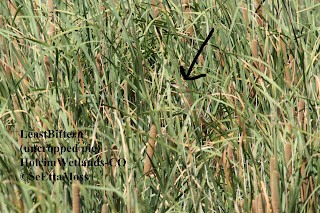Due to post surgery restrictions I haven't been able to get out to the Holcim Wetlands where the Least Bittern was found 2 weeks ago. Since then other birders have seen possible male and female birds raising the possibility that there might be breeding occurring. I went out this morning and looked for them from 7 am to 11 am--I could hear Least Bittern soft 'cooing' calls off and on but could not spot any birds. Interestingly, the location the calls were coming from was right where I had photographed the Least Bittern the first time as it hunted. When I left I stopped for some food in nearby Florence and checked my email on my Droid phone--a post this morning while I was at Holcim stating he had seen a male, a female and 2-3 fledglings yesterday between noon and 1pm. So I gobbled down my food and returned to Holcim Wetlands to try again, at this unusual mid-day time frame. Doug had made it sound like a piece of cake but it wasn't so for me. I had even sat on th...






